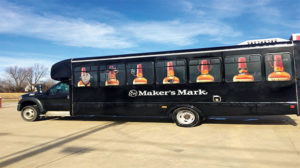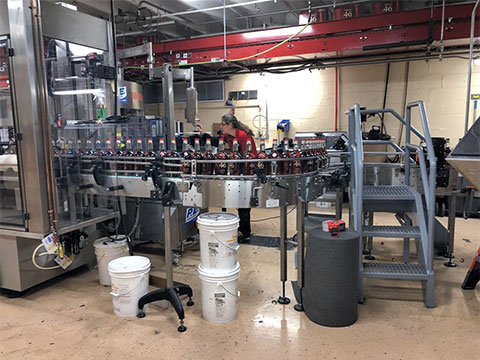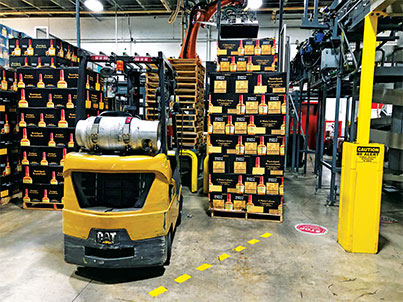Maker’s Mark better with age and autogas
Propane is making its mark at Maker’s Mark, a top-shelf purveyor of fine Kentucky bourbon sold in a distinctive squarish bottle hand-sealed in bright red wax.

Maker’s Mark is a top-shelf purveyor of fine Kentucky bourbon sold in a distinctive squarish bottle hand-sealed in bright red wax. Photo courtesy of Maker’s Mark.
Along with fueling an array of forklifts used for positioning during the production process, a propane-powered tour bus carries visitors across the expansive grounds and throughout the distilling facilities, storage areas and tasting rooms.
Located in Loretto, Kentucky, the iconic Maker’s Mark and its bucolic campus-like setting is a spirited vacation destination.
“They’ve become a major tourist attraction,” says Tom Underwood, executive director of the Kentucky Propane Education & Research Council (KYPERC), referring to the popular plant tours hosted by more than a dozen distilleries as part of the Kentucky Bourbon Trail and American Whiskey Trail tours.
“The Bourbon Trail is a huge tourism asset for the state of Kentucky, drawing Napa levels of people here to visit the historic distilleries, to learn about bourbon and take bourbon home,” says Underwood, referencing the travelers who frequent California’s wine country. “It’s a major industry in Kentucky.”
Sure Flame Propane, a division of United Propane Gas in Springfield, Kentucky, provides the propane to Maker’s Mark.
“We’ve had a bunch of new customers sign on,” says Sabrina Pyles, the office manager at the propane company.
And although the recent surge in business can’t all be directly attributed to the Maker’s Mark account, of course, Pyles is quick to point out the benefits stemming from the publicity and goodwill generated by the distillery’s local prominence and its use of propane.
A propane-fueled tour
Maker’s Mark is much admired for its ability to bring in much-valued tourist dollars for the entire region.

Maker’s Mark conducts tours of its distillery with a propane-fueled 30-passenger bus to reduce exhaust emissions and preserve the region’s natural resources. Photo courtesy of Mattingly Tours & Travel
A comfortable and sightseeing-friendly 30-passenger bus compartment perched atop a propane-fueled Ford F-550 chassis – plus the scurrying fleet of Caterpillar GP propane forklifts – comprise key ingredients of the Maker’s Mark two-hour tour, which costs $9 per person.
Propane spotlights the distillery’s focus on negating pollutants and conserving the region’s precious natural resources, says operations executive Jason Nally, who bears the official title of “environmental champion” at the company. He cites reduced exhaust emissions as an exceptionally important and visible element of propane’s role.
“We switched over to propane because we don’t have to have battery-changing stations, we don’t have to worry about a dead battery and we get better torque,” says Nally about the four forklifts.
Maintaining a standby supply of batteries was an additional, unwanted expense not incurred by using propane.
Bottled only when staff tasters agree that it is ready to roll, Maker’s Mark is aged for about six years. It is unique among distillers in that the American white oak barrels, aged outdoors for nine months to remove bitter tannins in the wood that would otherwise go into the bourbon, are rotated from the upper to lower levels of the aging warehouse to even out temperature differences. The upper floors are exposed to the greatest temperature fluctuations during the year, so rotating the 525-pound barrels ensures that the bourbon in all of the barrels is rendered with the same consistent quality and taste.
Although the boilers and chillers, plus the overall structural heating and cooling needs, are powered with natural gas and electricity, propane is more convenient for fueling the bus and forklifts, Nally says. An on-site refueling station consumes 500 to 600 gallons per month.
“They can pull right up to it and fill up,” he says.
Currently, there is one propane bus in use, augmented by a second diesel-powered unit that will eventually be replaced by a propane propulsion system.
“We’re going to be converting over to propane for the other bus at the end of its life,” says Nally, noting that additional LPG applications are under review.
“Knowing that we have a propane refueling site at our place,” he explains, “we know that there may be other opportunities available that utilize propane.”
With the touring vehicles being owned and operated by a third-party provider, Mattingly Tours & Travel of Bardstown, Kentucky, the propane bus has been in use for three years, according to Mattingly spokeswoman Dee Hurlburt.
Maker’s Mark requested the propane-fueled bus in support of the distillery’s environmental emphasis, she adds. Maintenance is conducted by an in-house technician at the agency’s headquarters.
Protecting the watershed

Propane used for forklifts eliminates the need for batteries and improves torque. Photo courtesy of Maker’s Mark
“The Maker’s Mark property is a beautiful park-like property, and propane plays a part in their efforts to conserve the area,” says Underwood at KYPERC. “Water is a big part of the distilleries. The local water is part of the bourbon mystique and recipe. They have to protect those assets any way they can. It’s a clean, green story.”
Maker’s Mark draws water from two spring-fed lakes, Nally notes.
“The limestone shelf where the distillery is located is key to crafting the unique taste of Maker’s Mark – the only distillery with its own water source and watershed,” he says.
An ancient underground layer of Kentucky limestone filters out the unpleasant presence of iron in the water, he adds, and “the pure calcium- and magnesium-rich water surrounding the distillery makes better drinking water and a better sour mash in which yeast can flourish.”
Reverse osmosis reclaims water that would otherwise be lost in the “small batch” production process.
Other sustainability efforts include implementing several acres of natural land buffers and planting thousands of trees and shrubs – more than 275 species are represented within the arboretum. Farmers are assisted with research-ready grains to determine the ideal varieties for the local soil and climate conditions.
Maker’s Mark is unusual in that no rye is used as part of the mash. Instead of rye, the mash contains red winter wheat (16 percent), along with corn (70 percent) and malted barley (14 percent). The product is 90 proof – or 45 percent alcohol.
Founded in 1805 on the banks of Hardin’s Creek as Burk’s Distillery, the property was purchased in 1953 by T. William “Bill” Samuels Sr., who established Maker’s Mark and its noted red wax seal. Customers on the plant tour who purchase a bottle of the product are still allowed to hand-dip their own seals.
















